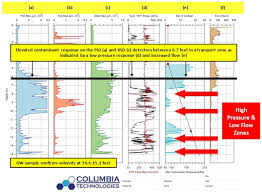For the remediation-focused site investigation professional, we believe that hydraulic permeability is no longer an option, but a requirement. As this post will outline, hydraulic permeability is key to identifying contaminant transport zones at LNAPL and DNAPL sites for remediation-focused site investigations. Hydraulic permeability data, which is collected with a Hydraulic Profiling Tool (HPT), enables decision makers to understand contaminant mobility and migration. Today, responsible parties and involved stakeholders are looking for more than just lab results from samples and screened well intervals, and are instead looking for data which enables them to minimize risk, reduce costs, and enhance remediation design efforts.
Below is an example of an HPT log from a site with multiple contaminants at concentrations up to and including NAPL. The combined Membrane Interface Probe-Hydraulic Profiling Tool (MiHpt) was used to delineate the horizontal and vertical extent of contamination and collect hydraulic permeability data simultaneously.
Key takeaways from the log included above:
- Between 6-7 feet, elevated contaminant response was observed as indicated on the PID (a) and XSD (c) detectors. This occurs in a transport zone as indicated by a low pressure response (d) and an increased flow zone (e).
- Within the same 6-7 feet interval, the low HPT pressure (d) and high flow zones (e) are indicative of contaminant transport. This transport is occurring despite tighter grain soils indicated by the Electrical Conductivity (EC).
- At 15 feet, a deeper contaminant response was again observed with elevated concentrations in a more permeable zone as indicated on the PID (a), FID (b), and XSD (c) detectors.
- A narrow seam of elevated permeability as displayed on the Estimated K graph (e) enables contaminant transport at a deeper depth.
- This data set displays the importance of collecting HPT permeability data (d and e) in conjunction with a MIP (or LIF) survey to provide more complete multiple lines of evidence of contaminant transport or storage.
So, what’s the value of HPT data and why should it be used during site investigations?
HPT data, which can be logged independently during an investigation, or with other remediation-focused direct sensing tools such as Laser Induced Fluorescence (LIF) or Membrane Interface Probe (MIP), supports decision makers in achieving remediation-focused project objectives. For additional information on direct sensing as a means of providing the most rapid and comprehensive information about the distribution and composition of soil and groundwater contamination, read our previous post, The 7 Biggest Myths of Direct Sensing (Part I).
LIF and MIP can be used both as an upfront investigation tools as well as planning tools for remediation. At high risk sites, use of LIF and MIP for targeting locations for sampling analyses and strategic well placements (including screen intervals) both within and outside the LNAPL and DNAPL body will allow one to precisely identify locations containing LNAPL and DNAPL.
The new generations of Hydraulic Profiling Tool (HPT) enable site decision makers to understand the details of soil permeability leading to LNAPL and DNAPL mobility and migration. Combining HPT data with LIF and/or MIP information enables site decision makers to more cost effectively select sampling locations early, thus eliminating the costly delays associated with traditional investigation tools and approaches. The permeability information is also critical to selecting remedial alternatives and properly placing injection and extraction intervals.
What Does Hydraulic Permeability Data Mean to Me?
While there are different approaches for collecting site investigation data to move forward with remediation design, those of us that rely on hydraulic permeability understand the importance to recognize what the data is telling you, and where you are able to draw conclusions respective to your specific site. At COLUMBIA Technologies, we call these conclusions “multiple lines of evidence” and it’s extremely important to understand what hydraulic permeability data is telling you in more permissive zones (low pressure and high flow zones), and where contaminants may or may not be flowing. These lines of evidence will allow you to design a more remediation-focused program moving forward and achieve your site objectives.
Do you have a LNAPL or DNAPL site you’re considering employing a site characterization strategy with hydraulic permeability? Contact us to further discuss your project or call us at + (888) 344-2704.


